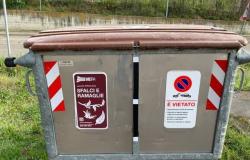The maxi-intervention in the former church of Santa Chiara in via Savigliano in Cuneo, which in recent months has been involved in the restoration of the frescoes, the vault and the dome, has officially concluded. The baroque building, owned by the Municipality of Cuneo, will be reopened to the public after eight years: appointment for Monday 17 June at 6pm.
The restoration works. The former church was in a poor state of conservation: the eighteenth-century stuccoes and the architectural elements which, in the past, were subject to repeated and constant infiltration of rainwater both from the roof and from the windows, were particularly compromised. The restoration intervention therefore affected all the frescoes present on the walls, the vault and the dome. Specifically, the cleaning of the frescoed parts was in-depth, with particular attention to the sections that showed strong detachments, and the glazing of all the decorated and stucco parts. The pictorial reintegration of the most valuable wall surfaces (figured parts and decorations) in the presence of abrasions, drops of paint film and gaps in stuccoed plaster was carried out, with watercolor colors according to the indications of the competent Superintendency. Finally, for the windows and doors, the replacement of all wooden ones that were no longer recoverable was planned and the external tinsmithery was cleaned. The works, carried out by the Lithos company of Venice for a total cost of 570,000 euros, were financed 80% by the “Culture Fund” of the Ministry of Culture while the remaining part comes from the Municipality of Cuneo thanks to an administration surplus. The municipal offices are currently working, according to the provisions of the Superintendence, on the relocation of two precious altarpieces, now kept in the museum deposits of the Cuneo civic collections. These are the Immaculate Conception of Beaumont (1738-1741) once located in the chapel of the same name inside the church, and San Tiburzio and Santa Cecilia, patroness of music, by an unknown author (mid-18th century), originally present above the right altar.
The future of Santa Chiara. In August 2022, a Special Public Private Partnership agreement was signed between the Municipality and the Il Melarancio Company, which for the next 25 years will deal with all aspects concerning the management, promotion and valorisation of the former church of Santa Chiara and Palazzo Soverini, a building from the first half of the 15th century located in Piazzetta del Teatro 1, near the Toselli Theatre, already home to the company since 2010. After the final finishing touches by the company, in December 2024 Santa Chiara will become a cultural hub for the Cuneo area. The technical setups, created with respect for the building, include the installation of a mobile stage and a raised floor. A small food area will be created in the former sacristy, while access to the internal courtyard will be reopened. Everything will be done with particular attention to the environment: solar panels will be installed on the roof of the adjacent building (now home to IPSIA) to power the church, while district heating will cover the remaining needs.
The reopening. The public event to reopen the property will be held on Monday 17 June at 6pm, which will be attended by Mayor Patrizia Manassero, Deputy Mayor Luca Serale (Public Works) and Councilor Cristina Clerico (Culture). The restoration work will be illustrated, while an artistic narration by Il Melarancio will retrace the history of the building. The company will also present an interesting environmental sustainability project which will be held on the same day at 9.15pm and will see 8 bicycles used which, once activated, will produce energy to turn on the internal lights. The former church will also remain open on Tuesday 18 June to allow those who wish to enter and admire the restored frescoes. On June 19th, however, a day open to stakeholders and anyone who wants to propose ideas for the design of the events that will animate the building in the coming months will be held together with Alberto Cuttica of Hangar Piemonte.
“Let’s reopen one of the most precious jewels of our city”. Thus the Mayor Manassero, the Deputy Mayor Serale and the Ass. Cleric: “After long and meticulous work by our offices and the designers in charge, we can finally return to the city one of its most precious and historically important jewels. We are very satisfied with the intervention carried out, which returns the building to its extraordinary original appearance and makes it accessible and usable again for the numerous cultural events that will be proposed in agreement with the Il Melarancio Company, with a view to greater social well-being of the community, with particular attention to our young people”.
“A path to undertake together with the community”. Thus the artistic director of the Il Melarancio Company, Gimmi Basilotta: “The former church will be a multifunctional cultural space, a place where people and organizations will be able to plan and implement initiatives and actions aimed at well-being: in fact, we imagine that the property will be able to become not just a performance hall, but a place open to citizens as cultural, recreational and meeting place. A bet for the future and a path to undertake together with the community.”
The history of the church. The building, built in the 18th century, is one of the most significant baroque monuments in Cuneo. Both the previous church and the adjoining convent of the Poor Clares are already mentioned in the correspondence of 1298. The current building, attributed with some uncertainty to Francesco Gallo, was built starting from 1712 leading, according to the writings, to a strong alteration of the old San Dalmazzo district.
The convent was very flourishing and welcomed the daughters of the major Cuneo families. Due to the laws regarding the forfeiture of ecclesiastical property in 1855, the Poor Clares had to cede the convent to the Municipality, giving rise to a rather singular episode: the nuns resisted for a long time until they were forcibly forced to leave the building on the night of August 3, 1857.
Subsequently, the church was reopened under the management of the Congregation of Salesians, who arrived in Cuneo around the 1920s. Here they remained until 1982, running the Civic Boarding School in via Cacciatori delle Alpi, open to all young people who studied in Cuneo but lived far away. In the 1990s, the church was deconsecrated and used for concerts in collaboration with the main city orchestras and academies, exhibitions and exhibition events which were also highly popular with the public such as the traditional nativity scene exhibitions, which were scheduled opportunities for valorisation and took place at inside the property until closing for security reasons.
The church is built with a Greek cross plan. A drum stands at the intersection of the two naves. A strongly pronounced cornice, supported by double Corinthian pilasters, strengthened by eight columns at the end of the arms, runs across the entire church and softens into the ellipse of the apse.
On the walls there are stucco decorations and paintings that frame the frescoes depicting saints, cherubs, angels and, in the dome, Santa Chiara together with San Francesco in front of the vault of heaven. The decoration dates back to 1719 with documented revivals in 1828 and is attributed to Domenico Beltramelli, while the frescoes in the figured panels are by Gian Carlo Aliberti and the wall decorations by Pietro Antonio Pozzi from Lugano.
Interventions already carried out
The works just completed are in continuity with a series of interventions completed in past years. In 1998 it was in fact subjected to: revision of the roof, installation of compliant toilets, replacement of the floor and arrangement of the walls of the large side room, control of the entrance door with provision for an emergency exit, construction of the electrical system and general heating system with temperature and humidity control system, installation of 150 seats and construction of the amplification system.
In 2011 the internal roofing was replaced and the door was restored. In 2012 the emergency lights were replaced again and the church was made safe with a check on all the stuccos and walls.
In 2015, the stone floor of the central nave was restored and the wooden confessionals were returned to their original location and subjected to maintenance.
In 2016, stucco falls, including large ones, were noted and the entire complex was therefore closed.




